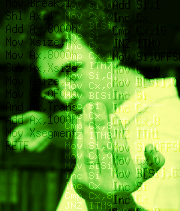J'ai quand-même commencé à tenter de dessiner un jet d'eau. J'avais lancé un appel sur twitter, pour essayer de trouver des références. Il faut dire que les cascades de l'époque 16-bit étaient encore plus convainquantes que les jets d'eau de la même période.
J'ai eu une réponse en or, du genre de celles que j'ai eues pour les arbres l'an dernier. Le temps de faire le point, et je vous raconte tout ça ;)
"I can't draw convincing water jet from below" did not sound like a very convincing reason for not using a water jet if it is the proper game mechanic to use. I finally have a good one to pixel study and started doing my own, as you can see on the photo, but allow me to rewind and start where it started.
Un pas en arrière pour revenir à l'époque 16-bit. On préférait souvent éviter d'avoir de trop grosses animations à gérer sur ce genre de machine, et animer de l'eau se faisait généralement avec un dégradé et une modification cyclique sur la palette de couleur (
palette cycling). Le foncé devient blanc pendant que le clair devient foncé, le très clair devient clair et le blanc devient très clair...
Back in the 16-bit era, it was frequent to do color cycling to animate a waterfall. Sometimes it worked nicely, sometimes it was so-so. It works best if the raster is long enough and if the animation speed remains movie-quality. At cartoon-12fps, you start seeing as flashing more than falling down water.
But you'll note the bottom of the waterfall is often missing in those scenes. And when you look at the few game art that tried having upwards water jet, you understand why: it no longer works. We expect water to become darker with density increase. In a waterfall, vertical density variation are interpreted as downwards waves, but when water eventually widens up in a fountain-like mushroom cap, it is always more dense at the center and less dense on the "edges". If you do palette-cycling here, you break that.
ça donne une illusion potable de cascade, pourvu qu'elle ne soit pas trop grande et que la vitesse d'animation soit réglée au millipoil. Et si possible, utilisez plus que 4 couleurs pour le cycle, parce que sinon on se retrouve avec quelque-chose comme le décor de Yoshi's Island qui tient plus du clignotement que de l'écoulement d'eau.

Et malheureusement, la même stratégie est appliquée dans les (nettement plus) rares jets d'eau de l'époque. Je dis "malheureusement" parce que pour un jet d'eau, on va forcément devoir aussi animer le "chapeau de champignon" qui va avec, pour lequel la surface animée est encore plus grande. Et l'effet clignotement encore amplifié. On l'a déjà dans Bubsy, où les pixels isolés clignotants ne parviendront pas à faire oublier le fait qu'ils sont statiques. On l'a dans le final de Link's Awakening et dans le jet d'eau d'un jeu obscur avec la mascotte du Mac Do.
In Bubsy, for instance, the artist sprayed out the water pixels as the water starts falling down. This is coherent with the style, but animating them will just give you blinking static pixels of water. And the stylized 'mushroom cap' used in Link's Awakening and Mac Do game flashes even more aggressively.

Là où ça coince tout particulièrement avec le "champignon", même quand on évite les pixels statiques, c'est qu'avec ce type d'image, le clair et le foncé ne sont plus interchangeables. On voudrait que le bord soit plus clair parce que l'eau y est plus éparpillée. Faites-y du palette-cycling et vous aurez des images qui donnent l'impression d'être en négatif.
J'avoue que je trouve un peu dommage qu'avec les resources graphiques de la SNES, on en soit réduit à ça pour animer l'eau. Mais il faut reconnaître qu'en misant tout sur de la RAM vidéo, la console n'a plus la possibilité de reprogrammer les plages d'adresses (bank switching) pour faire des "animations gratuites" comme la génération 8-bit. Toute animation va impliquer un transfert DMA vers cette VRAM et le budget pour ces transferts est limité (comme toujours).
Truly, the "cap" of the fountain/geyser needs dedicated animated tiles, but we're unlikely to see that on 16-bit engines. 8-bit machines could have done that with more ROM and evolved mapper chip, but 16-bit consoles no longer try to pull pixels directly from the ROM. They put them in dedicated video RAM, and rely on DMA channels to bring animation frames in due time. But the amount of pixels you can transfer per frame is limited. Animating Bubsy's geyser that way at 60fps would consume 25% of your animation power:
On NTSC with overscan mode turned off, there are 262 - 224 = 38
scanlines in vblank. Subtract one scanline for prerender time, and you
may end up with 165.5 * 37 = a smidge under 6 KiB per vblank.
6K, sur SNES, c'est 46 blocs-question de Super Mario World. Animer quelque-chose de la taille de la fontaine de Bubsy à 60fps, ça demanderait donc 1/4 de la puissance dans la partie critique du moteur de jeu.
Bon, et après l'époque 16-bit, alors ? Du côté de Super Princess Peach, par exemple, qui est plutôt réussi côté pixel art ? Un jeu ou pleurer est une mécanique de jeu, il doit bien y avoir des jets d'eau dedans non ?
So, well, my game is not for a 16-bit system anyway, so could there be any water jet pixel art for 32+ game that I could study instead ? Say, in Super Princess Peach ? A game where you cry waterjets sure should also have some geyser-like elements, right ?
Well, it does indeed, in Wavy Beach 2. It uses a "cone" of water that might be animated through color cycling plus a "flower" top that follows the rule "keep the center dark and the edges light". But even then, I don't find it appealing, and I don't see how I could make it match anything but the super-stylized environment of SPP.
Eh bien oui, en effet.
Dans le niveau 2 de la plage. Mais je dois bien avouer que je ne suis que moyennement emballé par le style. On a un premier élément (le cône) qui utilise un effet de palette qui ne fonctionne pas trop mal, les traîts latéraux restant sombres en permanence. Puis on a cette "fleur" qui grandit et rétrécit, gardant toujours le sombre au centre et se permettant des éclaboussures au bord des "pétales" sur la dernière frame.
Mais ... bof. Même en corrigeant le truc pour que la princesse apparaisse par-devant la fleur, ça ne me convainc pas. Oh, ça marche plutôt bien avec le reste de l'esthétique stylisée de SPP, mais ce type d'animation dans Bilou ? Pas convaincu.
Et depuis ? Parce que bon, le modèle pour la cascade de Bilou, il ne date pas de 2005. Mais le truc, c'est que j'ai surveillé les cascades en pixel art pendant pas mal d'année, sachant que j'en aurais besoin tôt ou tard. Alors que des geysers, c'est plutôt un truc de dernière minute.
Et c'est là que hot_pengu, l'auteur de Goodboy Galaxy, m'a pointé vers la vidéo de son jeu sur GBA
And so I finally asked hints to people on twitter who might have seen something I could use as a reference, or ever proper keywords to search for one, and to my surprise, I received an answer from indie game developer hot_pengu:
We call it a 'geyser' internally for goodboy, and this (timestamped vid) is how we represent it.
Je jette un oeil, je prends un petit screenshot pas fou mais qui pourrait donner un point de départ, et là,
Here's a better look, if it's useful! (there's two versions, one comes out of a monster)
He added as I posted a quick snapshot for future pixel study, handing the Goodboy Galaxy spritesheet with 2 sizes of exactly-what-I-needed material that you see printed on the top photo. 6-frame stunning animations, with tileable base and stylish top. Even the style isn't that different from
the one I have for my waterfall!
Une animation pixel-art moderne, tout en fluidité et utilisant bien les 6 frames, qui peut être étirée en hauteur comme on veut ! C'est celle que vous avez vu tout en haut de cet article, imprimée et que je suis occupé à étudier. Parce que là, j'ai bien mieux qu'une référence pour donner une seconde chance au cas du bouchon: j'ai une idée.
Voyez, ce geyser, je peux le placer au fond du trou, directement, sans avoir besoin de bouchon. Il bouge, il attire l'attention. Pas moyen que le joueur ignore sa présence. Il a un look quelque-part entre la plate-forme et le bumper ... on pourrait toujours sauter dessus, on ne sait jamais.
I like how it simply requires the player to hop into the proper spot to trigger. Much cleaner gameplay than the "pull the cover" I had thought about, but it remains interactive. Plus, by being already flowing before we interact, there's no more questions about "where does this water comes from, where does it goes afterwards", etc.
Deuxième bon point, une fois que Bilou a sauté dessus, je peux réutiliser le type de comportement que le joueur rencontrera plus tard avec Inkjet: Bilou reste "coincé", la pression s'accumule et wouf! on est projeté vers le haut.
And that would match the way 'inkjet' monsters will lately be used as delayed bumpers in the School Zone ... Since this game will no longer feature a welcome screen with the inkjet, it's a good thing the player can be shown early what happens after the "caught in a boiling pot" animation.
Et si il a raté son premier saut, il peut retomber sur le "chapeau" du geyser et re-sauter de là.
.png) Mieux encore: si le joueur n'est pas resté dans le geyser jusqu'à être projeté, on peut le pousser vers le haut s'il entre en contact avec le "pied" du geyser. Et si rien de tout ça ne se produit, on peut directement réessayer la même manipulation. Pas de risque d'aller se coincer en nageant, de faire redescendre l'eau trop tôt ou quoi que ce soit de ce genre.
Mieux encore: si le joueur n'est pas resté dans le geyser jusqu'à être projeté, on peut le pousser vers le haut s'il entre en contact avec le "pied" du geyser. Et si rien de tout ça ne se produit, on peut directement réessayer la même manipulation. Pas de risque d'aller se coincer en nageant, de faire redescendre l'eau trop tôt ou quoi que ce soit de ce genre.
Bref, j'avais pensé vous redessiner *mon* geyser sur DS pendant la petite semaine de vacances, mais au final, j'ai juste eu le temps de faire une petite feuille de notes pour illustrer ce que j'imagine comme mécanique avec mon geyser ... parce que les vacances d'une famille 11 + 15, ça ne ressemble pas vraiment à la dynamique 8 + 12 et ses plaines de jeu à surveiller :-P
I expect that the platform-look of the geyser top will invite even the younger players to jump on. I expect that its animation will catch their attention much more than a purple block or handle. Should they fail to use the bump effect to reach the key, they can be caught by the platform-top and jump again. If they jumped out before the geyser happened, they can jump into the flowing geyser and be pushed up to the platform-top. It's flawless ^_^
Now I just need to find enough time in the upcoming evenings to complete it ^^"
PS: if you want to animate something like that, consider animating it without the vertical motion first: just the wobbles and the sparkles, and only then apply the vertical shift to each frame. Unsure I will follow that advice myself this time.



%20-%20YouTube.png)




.png)



 Vote for your favourite post
Vote for your favourite post


